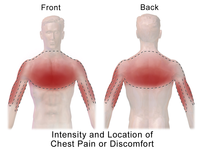
Photo from wikipedia
To detect ischemia in patients with angina and normal coronaries frequently represents a complex diagnosis. To investigate whether left ventricular mechanical dyssynchrony by phase analysis contributes in the evaluation of… Click to show full abstract
To detect ischemia in patients with angina and normal coronaries frequently represents a complex diagnosis. To investigate whether left ventricular mechanical dyssynchrony by phase analysis contributes in the evaluation of patients with chest pain and normal coronaries, gated-SPECT myocardial perfusion imaging (MPI) at rest and 30 minutes post-stress was performed in 218 patients with normal epicardial coronaries, who were divided into two groups: those with summed difference score (SDS) ≥ 4 (54 patients, Group 1), and those with SDS < 4 (164 patients, Group 2). Intraventricular synchronism-phase standard deviation (PSD) and histogram bandwidth (HBW)—was evaluated by phase analysis. Women were significantly more frequent in Group 2 (those without ischemia in SPECT MPI): 113 (69%) vs 25 (46%), P = .00001. In males, left ventricular ejection fraction (LVEF) and ventricular volumes were not significantly different between patients with or without ischemia. However, ischemic females showed significantly higher ventricular volumes, minor post-stress LVEF and more negative delta LVEF (− 3.9 vs 0.34, P = .0008) than the non-ischemic ones. There was a significant post-stress increase of PSD and HBW among males, although not among females. According to SSS (≥ 4, with ischemia/necrosis; < 4, without ischemia/necrosis), post-stress PSD and HBW significantly increase both in male and female, and PSD and HBW were significantly higher in females with SSS ≥ 4 compared to those with SSS < 4 (PSD rest: 19.04° vs 11.72°, P < .0001; HBW rest: 58.85° vs 38.21°, P < .0001). PSD and HBW were also higher among males with SSS ≥ 4 compared to those with SSS < 4, although not significantly. Higher ventricular volumes in females and dyssynchrony are associated with inducible ischemia in MPI in patients with chest pain and normal coronaries. Stress-induced ischemia increases degree of dyssynchrony.
Journal Title: Journal of Nuclear Cardiology
Year Published: 2019
Link to full text (if available)
Share on Social Media: Sign Up to like & get
recommendations!